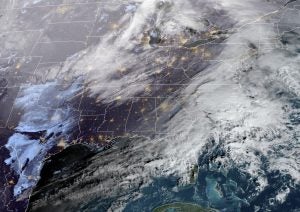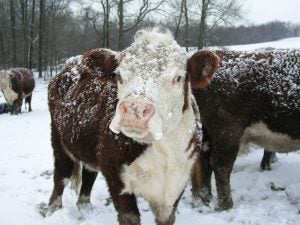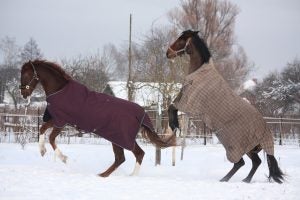If you live in states like Kentucky, Tennessee, Virginia, and North Carolina, there’s certainly no guarantee year to year of getting a white Christmas — snow and below-freezing temperatures don’t consistently roll in until January. But those vulnerable areas — and many other regions of the country — are now prepping for an intense blast of pre-Christmas arctic chill Friday and Saturday. Some states have already seen the mercury drop sharply as of this morning.
Couple all of this with the possibility of rain today in some spots, and it’s a tricky setup for battling icy power outages, keeping animals comfortable, and making sure the equipment stays running.
“This will likely be the coldest air we’ve seen in Kentucky since the winter of 2015,” said Matt Dixon, agricultural meteorologist for the University of Kentucky College of Agriculture, Food and Environment’s Ag Weather Center. “In fact, we’ll likely see wind chills in the -10 to -20 range. The livestock heat stress index will run in the emergency category for most of Friday and through the weekend. Now is the time to take precautions. Following rain on Thursday, a flash freeze will be possible after the arctic front passes the area. Plan ahead and leave a day early if you’re traveling for the holidays.”

Unlike homes in more northern states, homes and barns more toward the South aren’t built with the same levels of insulation — that means pipes freeze quicker, weaker electric heat pumps are more common, and governmental agencies aren’t as equipped with salt and plows to maintain roadways.
According to the National Weather Service, for Friday night, both Chattanooga, Tennessee, will see 7 degree temps and a minus-5 wind chill, Roanoke, Virginia, is supposed to get to a low of 6 degrees with a minus-9 wind chill, and Raleigh, North Carolina, should hit 14 degrees with a 1-degree wind chill.
Reuters reported that in all, about 200 million people in the Lower 48 states were under extreme weather alerts as a freezing air mass descended from the Northern Plains, sending temperatures into a nosedive, said Bob Oravec, a forecaster with the National Weather Service.
It probably goes without saying that livestock animals will need extra attention during this time. Adequate shelter, water, dry bedding and enough feed to make it through cold periods are vital elements to surviving these weather patterns. All outdoor livestock are at greater risk because they will not have enough time to adapt to the expected rapid drop of 30 to 40 degrees in just a few hours.

Animals have a higher requirement for energy in the colder months, which means they need high-quality grains and forages.
“The average horse, with a lower activity level, should eat between 1.5 and 2 percent of its body weight in feed per day to maintain its weight,” said UK equine specialist Bob Coleman. “That feed requirement goes up in winter, as horses use more calories to keep warm. Provide extra hay and make sure horses have shelter to get out of windy, damp weather.”
Horses, livestock, and pets must have access to clean, unfrozen water. Coleman said to check often to ensure water sources are open and thawed. Decreased water intake affects dry matter intake.
Ambient temperatures can impact the amount of dry matter livestock consume, providing an opportunity to compensate for increased maintenance energy needs. Producers either need to increase their animals’ feed intake or increase the energy density of the diet by feeding higher quality hay or adding more grain or fat to the grain mix, UK beef specialist Jeff Lehmkuhler said.
“As the temperature declines below this lower critical value, the maintenance energy value for the animal is increased to maintain core body temperature,” Lehmkuhler said. “Animals maintain core body temperature by increasing their metabolism, resulting in greater heat production, as well as other heat conservation strategies, such as reducing blood flow to the extremities, shivering and increased intake.”
External and internal insulation influence the lower critical temperature. External insulation is the depth and thickness of the hair coat, condition of the hair coat and thickness of the hide. Thin-hided cattle, such as dairy breeds, tend to have a lower insulating factor than thick-hided breeds like Herefords. The condition of the hair coat is critical as an external insulation barrier.

Dairy producers should make sure cows’ teats are dry before turning animals out when temperatures fall below 25 degrees Fahrenheit.
“If you turn out an animal with a wet udder or teats, frostbite is almost a certainty,” said Michelle Arnold, UK extension veterinarian. “Treat signs of frostbite immediately. Frostbite on the teat ends can quickly lead to damage of the keratin seal, and that can allow mastitis-causing bacteria to enter the udder.”
Additionally, the UK College of Agriculture, Food and Environment emphasizes that dry bedding is vital. Cattle, goats, or sheep laying in wet bedding are at risk for frostbite. Producers should make sure to keep animals’ hair coats as dry and as clean as possible.


